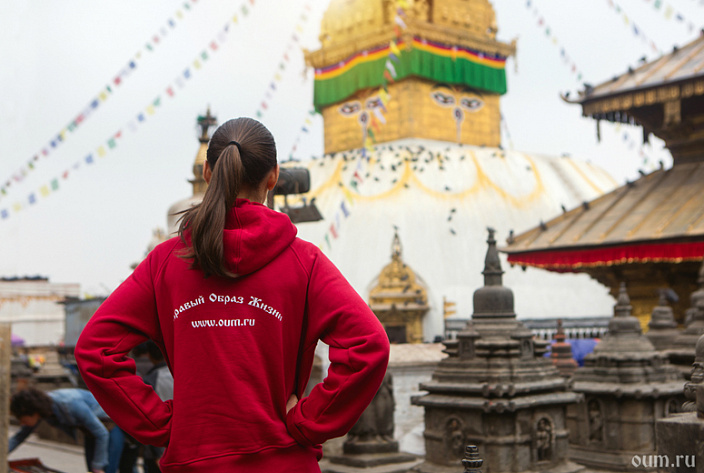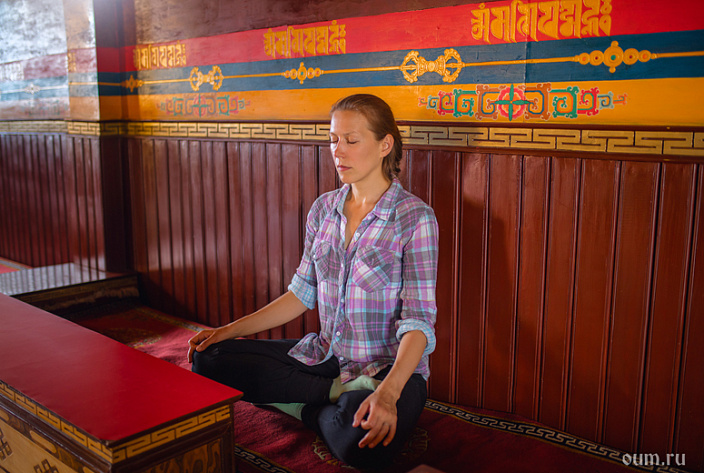V In this article, we will consider the concept of contemplation from various angles, so that the reader can broadly imagine the nature of this phenomenon. We will look at how the term “contemplation” is understood in various philosophies and how you can apply the practice of contemplation for the benefit of your health.
Contemplation is a method of cognitive activity, which is realized as a direct relation of consciousness to an object. This is the scientific description of the term “contemplation.” In European philosophy, Immanuel Kant was one of those who stood at the origins of the study of this phenomenon. We are aware of the idealistic orientation of the philosopher’s works.
In this particular case, it would be interesting to look and compare how a typically European philosopher, brought up on Christian culture and its values, comes to more or less similar conclusions with Buddhist thinkers in terms of understanding “contemplation” as a category opposite to the empirical (practical) knowledge of the world, and nevertheless, bringing contemplation to the very level when it surpasses this very practical knowledge, because contemplation is direct, it does not build walls between the observer and the observed, and therefore, the possibilities to understand the thing being studied or the phenomenon in its unchanged state are immeasurably greater than with the empirical study of things.
Contemplation, although it can be translated as contemplation, which means thinking, but this is not logical thinking, when the mind is connected to immediately use the tools at its disposal: assessment, comparison, logic. Contemplation is an a priori prerequisite for perception, that is, contemplation is not a result to which intellectual or spiritual activity leads, but first of all a given, what lies at the foundation and without which further reflections, reflection would be impossible.
For Kant, contemplation and representation are interchangeable concepts, since to explain his conclusions, Kant used the word “Anschauung”, which in translation means “view”, “visual representation”, the same “comtemplation”. If we analyze the course of his thought, it will become clear why this particular word was chosen. In German, the root schau means ‘to look’. To look is to contemplate.
We will not dive deeply into the study of the morphology of the Russian word “contemplation”, but even on an intuitive level, one feels that contemplation has a connection with such words as “see”, “mirror”. The latter is perhaps especially interesting for us, since the very phenomenon of contemplation is nothing more than gazing into the mirror of being. Being is represented by what surrounds us. Therefore, what we see is a reflection of ourselves, or otherwise, nature is what we are. This seemingly not quite familiar conclusion does not at all contradict the philosophy of the Vedas, where Prakriti is the concept of matter, nature, which merging with Purusha, the world soul, “I”, creates the Universe.
Returning back to the philosophy of Kant, we cannot say that the understanding of contemplation by the great thinker from Königsberg was identical to that which can be gleaned from the Vedas. However, Kant does not remain in place in his reflections and, first of all, calls space and time a priori forms of contemplation, that is, those without which no further contemplation would be impossible, because everything, whatever we perceive, is first of all perceived us through the prism of space and time. In this sense, Kantian theory is no less fundamental than Vedic philosophy.
Contemplation is viewed as a global phenomenon from the point of view of Vedantism and Kantianism. Later, contemplation will be reduced to a narrow concept from the field of psychology, and it will also be adopted by the followers of the New Age, so the fundamental nature of this concept will be reduced to a certain extent only to the practice of relaxation techniques. But let’s continue talking about contemplation and nature.
The nature of contemplation is that you study what immediately surrounds you, but not with the help of such familiar means as analysis using logic, but by passing them, without overcoming them, but walking in a different way, directly. Contemplation is a direct study of reality as it is. Passing through the barriers set by the mind, you see with your inner gaze what is, and this is the very essence of Buddhism. Remove the last remaining veils and look at the world with an open eye, see it without prejudice. This, in turn, is possible only when the space around us, things and we become one. It is, in fact, meditation in practice without the use of special techniques of meditation, such as consciously focusing on something, controlling the breath, or purposefully getting rid of the thought process.
Immersion in the very process of contemplation is de facto meditation. Even more effective can be considered the contemplation of nature as such. It is customary for a person to observe natural processes. Shifting our attention to them, we do not notice how we turn from a researcher of natural phenomena into artists contemplating their nature from afar, first admiring it, and later uniting with it into a single whole. Just as the artist and the image of his painting are one, so Man and Nature are inseparable. Civilizational progress sometimes manages to convince a person of the opposite, to make him believe that he is the master of the world around him, and not a part of it.
The point here is not to belittle human nature, presenting him as part of the mosaic instead of the ruler. It’s about something else. Civilization, raising a person supposedly above Nature, thus excludes him from its composition, and he rules over her exclusively from a position of strength. While the real state of affairs does not detract from the true status of a person at all. Man is not a master, but a part of the creation of Nature, and in him Nature manifests itself in the form of quintessence. Rising above Nature, considering it lower than ourselves, we thereby consciously doom ourselves to isolation, while by origin we are destined to be not so much a separate part of Nature as it is!
In man, the power of Nature manifested itself as in nothing else. Man is the Universe. But, unfortunately, we deliberately take off this precious crown, exchanging it for the brilliant crown of the ruler of progress. What is technical progress in comparison with the unprecedented depths of the oceans and cosmic distances? Yes, just a tool, and very imperfect, for the study of this very Universe, which has not yet been unraveled and is unlikely to succeed. After all, if we think that this is possible, then we admit to ourselves that we, with our imperfect methods and tools, are able to comprehend the perfection of the Universe. The unknowability of the Universe, no matter what means we use, proves to us its infinity and at the same time indicates that our essence cannot be initially determined, but its scales can be measured, since we are this Universe.
Contemplation is an instant grasp of what is, insight. This is how the thinkers of the past defined this phenomenon. In simple words, contemplation – this is the knowledge of God as he is. There is some contradiction here, but this is only at first glance, since the imperfection of the semantics of linguistic structures does not allow us to express ourselves more precisely. We must always remember that a language is just a catchy code for conveying some logical concepts. But language is of little help when we are dealing with concepts that go beyond what can be understood by logic.
When we say that contemplation is the cognition of God, we do not mean an anthropomorphic God, that is, some kind of humanoid image. On the contrary, here the emphasis is placed on the idea of pantheism (it should not be understood as paganism), when “Everything” – “pan” is “God” – “theos”, and the Universe implies the unity of all parts of the universe.
To some extent, the teachings of Vedanta fall into the same category, because there also does not exist God in the form of a man. Brahman is also not a creator god, but a certain beginning, a substance that exists as a given. At the same time, he does not occupy a leading position in the hierarchy, he is himself in everything and his reason is in himself. This is the striking similarity of ancient Vedic knowledge with the concept of pantheism, which was developed much later, already in the 2nd half of the second millennium of our era. Outstanding representatives of this philosophical and religious teaching were Giordano Bruno, Meister Eckhart and Benedict Spinoza.
Thus, contemplating Nature, we contemplate God, we cognize God through Nature, because Nature is the embodiment of God. Many words have been said that contemplation sharpens the mind and uplifts the soul… What are these serious findings based on? Of course, we logically understand that this is so, but it does not hurt to reinforce our intuitive understanding with recent discoveries made by specialists from the University of Sheffield. “The data obtained in the process of measuring the activity of the brain, confirmed the fact that natural landscapes strengthen the connections of the brain and synchronize the work of its various zones, and artificial landscapes, on the contrary, disrupt these connections and introduce imbalances in the work of the brain.”
The point here is that contemplation of landscapes of nature affects the human brain as meditation. After all, a person’s immersion in the meditation process leads to a similar effect – synchronization of the work of both hemispheres of the brain and, as a result, a more multifaceted perception of the world, a deeper understanding of it. We can say that the practice of meditation, regardless of finding out the reasons for what contributed to the immersion in a meditative state, is a powerful tool for self-development.
You can not follow the instructions for doing meditation, sitting in the Lotus position and concentrating on the cycles of inhalation and exhalation, and at the same time go into a meditative state by contemplating the picturesque surroundings of the area where you decide to spend your free time. Although this, in fact, is not the main thing. The most important thing is your attitude. If you are inclined to see beauty, you will see it. If, in addition, you are not inclined to excessive rationalization, you avoid drawing any conclusions of a positive or negative order, then you can bypass the traps of consciousness and really plunge into full, real contemplation, which will open the doors to the world of meditation for you.
The practice of contemplation or meditation can be built on anything. These can be ordinary objects, some kind of inner images, or it can even be the flow of your own thoughts, as one of the types of meditation, when you have to observe your own thoughts flowing smoothly in front of you, while not giving preference to any of them, but only allowing them to appear and fade away.
Contemplation of the sun can also be seen as an object for meditation. There is such a direction, the followers of which are engaged in contemplation of the sun (Sungazing). Although for them it is more of a therapeutic practice, however, it should not be ruled out that unconsciously at this moment, immersion in the state of meditation also occurs, and at least in part the therapeutic effect that takes place here can be attributed to meditation.
Practical contemplation can help you deal with stress. Immersion in a new state of consciousness will free the mind from endless worries, which will also have a beneficial effect on the state of health. It is sometimes necessary to give the brain a break in its tireless activity, and the practice of contemplation will serve as the beginning of the cessation of the internal dialogue.
Set aside at least one day a week to go out in nature or simply immerse yourself in meditation, contemplating the space around you. It’s not difficult at all. Sometimes we unconsciously find ourselves in this state, not noticing it. But such moments need to be noted, since they can lay the foundation for subsequent regular meditation practices and work on oneself.





